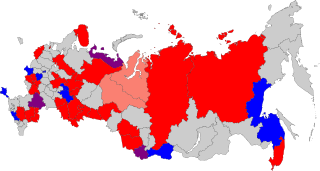Urban-type settlement is an official designation for a semi-urban settlement, used in several Eastern European countries. The term was historically used in Bulgaria, Poland, and the Soviet Union, and remains in use today in 10 of the post-Soviet states.

The Komi Republic, or Komi is a federal subject of Russia. Its capital is the city of Syktyvkar. The population of the republic, as of the 2010 Census was 901,189.

The Komi or Komi-Zyryans (Zyryans), are a Permian (Finno-Ugric) ethnic group whose homeland is in the north-east of European Russia around the basins of the Vychegda, Pechora and Kama rivers. They mostly live in the Komi Republic, Perm Krai, Murmansk Oblast, Khanty–Mansi Autonomous Okrug, and Yamalo-Nenets Autonomous Okrug in the Russian Federation.
Okrug is an administrative division of some Slavic states. The word "okrug" is a loanword in English, but it is nevertheless often translated as "area", "district", or "region".

Russia is divided into twelve economic regions —groups of federal subjects sharing the following characteristics:

The federal subjects of Russia, also referred to as the subjects of the Russian Federation or simply as the subjects of the federation, are the constituent entities of Russia, its top-level political divisions according to the Constitution of Russia. Since March 18, 2014, the Russian Federation constitutionally consists of 85 federal subjects. The two located on the Crimean Peninsula, Sevastopol and the Republic of Crimea, are not internationally recognized as part of Russia. Kaliningrad Oblast is the only federal subject separated by other countries.

.ru is the Latin alphabet Internet country code top-level domain (ccTLD) for the Russian Federation introduced on April 7, 1994. The Russian alphabet internationalized country code is .рф.
Selsoviet is a shortened name for a rural council and for the area governed by such a council (soviet). The full names for the term are, in Belarusian: се́льскi саве́т, Russian: се́льский сове́т, Ukrainian: сільська́ ра́да. Selsoviets were the lowest level of administrative division in rural areas in the Soviet Union. After the dissolution of the Soviet Union, they were preserved as a third tier of administrative-territorial division throughout Ukraine, Belarus, and some of the federal subjects of Russia.

This gallery of flags of federal subjects of Russia shows the flags of the 85 federal subjects of Russia.

The following outline is provided as an overview of and topical guide to Russia.
Russia, the largest country in the world, has international borders with 16 sovereign states, including two maritime boundaries with the United States and Japan, as well as the borders with the partially recognized states of South Ossetia and Abkhazia. The country has a land border running 20,241 kilometres (12,577 mi) in total, and has the second-longest land border of any country in the world, after China. The present borders of the Russia have been drawn since 1956, and had remained the same after the dissolution of the Soviet Union; until in 2014, when Crimea was annexed by Russia from Ukraine.

The Russian Soviet Federative Socialist Republic, previously known as the Russian Soviet Republic and the Russian Socialist Federative Soviet Republic as well as being unofficially known as Soviet Russia, Russian Federation or simply Russia, was an independent socialist state from 1917 to 1922, and afterwards the largest and most populous of the Soviet socialist republics of the Soviet Union (USSR) from 1922 to 1991, until becoming a sovereign part of the Soviet Union with priority of Russian laws over Union-level legislation in 1990 and 1991, the last two years of the existence of the USSR. The Russian Republic was composed of sixteen smaller constituent units of autonomous republics, five autonomous oblasts, ten autonomous okrugs, six krais and forty oblasts. Russians formed the largest ethnic group. The capital of the Russian SFSR was Moscow and the other major urban centers included Leningrad, Novosibirsk, Sverdlovsk, Gorky and Kuybishev.
Zarechny, Zarechnaya, or Zarechnoye is the name of several inhabited localities in Russia.
Northern Krai was a krai of the Russian Soviet Federative Socialist Republic from 1929 to 1936. Its seat was in the city of Arkhangelsk. The krai was located in the North of European Russia, and its territory is currently divided between Arkhangelsk, Vologda, Kostroma, and Kirov Oblasts, the Nenets Autonomous Okrug, and the Komi Republic.

The Central Military District is a military district of Russia.
Priozerny/Priozyorny, Priozernaya/Priozyornaya, or Priozernoye/Priozyornoye is the name of several rural localities in Russia.

Election Day in Russia was held on September 14, 2014.

Election Day in Russia was 18 September 2016. Among them were the legislative election for the 7th State Duma, nine gubernatorial elections, 39 regional parliamentary elections, and many elections on the municipal and local level.